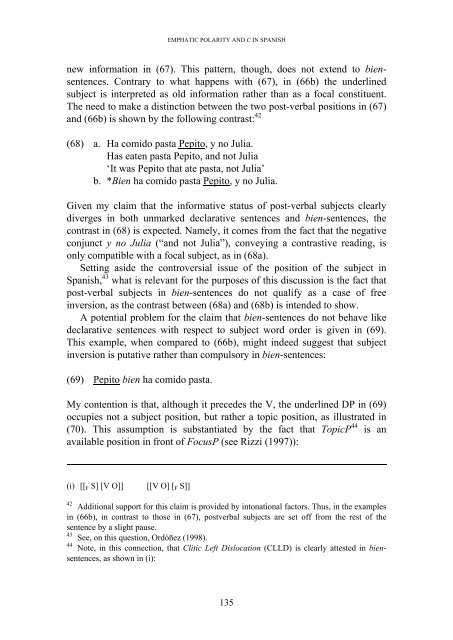Emphatic Polarity and C in Spanish - Lear
Emphatic Polarity and C in Spanish - Lear
Emphatic Polarity and C in Spanish - Lear
You also want an ePaper? Increase the reach of your titles
YUMPU automatically turns print PDFs into web optimized ePapers that Google loves.
EMPHATIC POLARITY AND C IN SPANISH<br />
new <strong>in</strong>formation <strong>in</strong> (67). This pattern, though, does not extend to biensentences.<br />
Contrary to what happens with (67), <strong>in</strong> (66b) the underl<strong>in</strong>ed<br />
subject is <strong>in</strong>terpreted as old <strong>in</strong>formation rather than as a focal constituent.<br />
The need to make a dist<strong>in</strong>ction between the two post-verbal positions <strong>in</strong> (67)<br />
<strong>and</strong> (66b) is shown by the follow<strong>in</strong>g contrast: 42<br />
(68) a. Ha comido pasta Pepito, y no Julia.<br />
Has eaten pasta Pepito, <strong>and</strong> not Julia<br />
‘It was Pepito that ate pasta, not Julia’<br />
b. *Bien ha comido pasta Pepito, y no Julia.<br />
Given my claim that the <strong>in</strong>formative status of post-verbal subjects clearly<br />
diverges <strong>in</strong> both unmarked declarative sentences <strong>and</strong> bien-sentences, the<br />
contrast <strong>in</strong> (68) is expected. Namely, it comes from the fact that the negative<br />
conjunct y no Julia (“<strong>and</strong> not Julia”), convey<strong>in</strong>g a contrastive read<strong>in</strong>g, is<br />
only compatible with a focal subject, as <strong>in</strong> (68a).<br />
Sett<strong>in</strong>g aside the controversial issue of the position of the subject <strong>in</strong><br />
<strong>Spanish</strong>, 43 what is relevant for the purposes of this discussion is the fact that<br />
post-verbal subjects <strong>in</strong> bien-sentences do not qualify as a case of free<br />
<strong>in</strong>version, as the contrast between (68a) <strong>and</strong> (68b) is <strong>in</strong>tended to show.<br />
A potential problem for the claim that bien-sentences do not behave like<br />
declarative sentences with respect to subject word order is given <strong>in</strong> (69).<br />
This example, when compared to (66b), might <strong>in</strong>deed suggest that subject<br />
<strong>in</strong>version is putative rather than compulsory <strong>in</strong> bien-sentences:<br />
(69) Pepito bien ha comido pasta.<br />
My contention is that, although it precedes the V, the underl<strong>in</strong>ed DP <strong>in</strong> (69)<br />
occupies not a subject position, but rather a topic position, as illustrated <strong>in</strong><br />
(70). This assumption is substantiated by the fact that TopicP 44 is an<br />
available position <strong>in</strong> front of FocusP (see Rizzi (1997)):<br />
(i) [[ F S] [V O]] [[V O] [ F S]]<br />
42<br />
Additional support for this claim is provided by <strong>in</strong>tonational factors. Thus, <strong>in</strong> the examples<br />
<strong>in</strong> (66b), <strong>in</strong> contrast to those <strong>in</strong> (67), postverbal subjects are set off from the rest of the<br />
sentence by a slight pause.<br />
43<br />
See, on this question, Ordóñez (1998).<br />
44<br />
Note, <strong>in</strong> this connection, that Clitic Left Dislocation (CLLD) is clearly attested <strong>in</strong> biensentences,<br />
as shown <strong>in</strong> (i):<br />
135

















